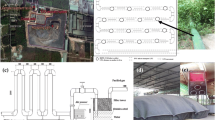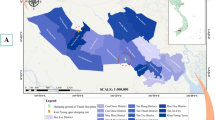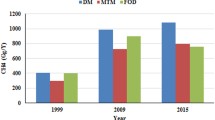Abstract
The methane (CH4) emissions from urban sources are increasing, and they depend on the processes and technologies applied in each one. Thus, studying them individually to quantify their emissions and understand their behavior to design CH4 mitigation strategies is meaningful. Although many studies have been carried out in different cities worldwide, the complex methodologies and technologies applied are not readily available in developing countries. The main objective of this work is to apply a simple and inexpensive methodology to collect air samples in urban areas using syringes with a three-way stopcock. Considering the baseline concentration in different urban zones, the WWTP contribution to atmospheric CH4 concentration was assessed. Moreover, it was possible to estimate the CH4 emission rate from the source by applying the inverse Gaussian model. The atmospheric CH4 concentrations inside and around the WWTP varied from 2.04 to 32.78 ppm. Most of the highest concentrations were found inside the WWTP; however, high concentrations were found up to 500 m from its center. The values in the urban zones were between 2.06 and 3.52 ppm, consistently higher in the area with the highest population density. Finally, considering the WWTP as a single source and according to the operational and atmospheric conditions during the studied period, the mean CH4 emission rate from this source was 2.08E + 04 μg s−1. The proposed sampling methodology could be applied to estimate CH4 emission rates from fixed sources in areas with overlapping sources.



Similar content being viewed by others
Availability of data and materials
The datasets generated during the current study are available in the Mendeley Data repository: https://data.mendeley.com/datasets/c7hjmtrbp8/1. Stadler, Carla Sofía; Fusé, Victoria Susana; Linares, Santiago; Juliarena, Maria Paula (2021), “Atmospheric CH4 concentration in a WWTP and different urban zones”, Mendeley Data, V1, https://doi.org/10.17632/c7hjmtrbp8.1.
Code availability
Not applicable.
References
Ahmed, E., Kim, K. H., Jeon, E. C., & Brown, R. J. C. (2015). Long term trends of methane, non methane hydrocarbons, and carbon monoxide in urban atmosphere. Science of the Total Environment, 518–519, 595–604. https://doi.org/10.1016/j.scitotenv.2015.02.058
Aliaga, V. S., Ferrelli, F., & Piccolo, M. C. (2017). Regionalization of climate over the Argentine Pampas. International Journal of Climatology, 37, 1237–1247. https://doi.org/10.1002/joc.5079
Blaha, D., Bartlett, K., Czepiel, P., Harriss, R., & Crill, P. (1999). Natural and anthropogenic methane sources in New England. Atmospheric Environment, 33(2), 243–255. https://doi.org/10.1016/S1352-2310(98)00153-8
Caulton, D. R., Li, Q., Bou-Zeid, E., Fitts, J. P., Golston, L. M., Pan, D., Lu, J., Lane, H. M., Buchholz, B., Guo, X., McSpiritt, J., Wendt, L., & Zondlo, M. A. (2018). Quantifying uncertainties from mobile-laboratory-derived emissions of well pads using inverse Gaussian methods. Atmospheric Chemistry and Physics, 18(20), 15145–15168. https://doi.org/10.5194/acp-18-15145-2018
Chamberlain, S. D., Ingraffea, A. R., & Sparks, J. P. (2016). Sourcing methane and carbon dioxide emissions from a small city: Influence of natural gas leakage and combustion. Environmental Pollution, 218, 102–110. https://doi.org/10.1016/j.envpol.2016.08.036
Czepiel, P. M., Crill, P. M., & Harriss, R. C. (1993). Methane emissions from municipal wastewater treatment processes. Environmental Science and Technology, 27(12), 2472–2477.
Daelman, M. R. J., van Voorthuizen, E. M., van Dongen, U. G. J. M., Volcke, E. I. P., & van Loosdrecht, M. C. M. (2012). Methane emission during municipal wastewater treatment. Water Research. https://doi.org/10.1016/j.watres.2012.04.024
Daelman, M. R. J., Van Voorthuizen, E. M., Van Dongen, L. G. J. M., Volcke, E. I. P., & Van Loosdrecht, M. C. M. (2013). Methane and nitrous oxide emissions from municipal wastewater treatment - Results from a long-term study. Water Science and Technology, 67(10), 2350–2355. https://doi.org/10.2166/wst.2013.109
Delre, A., Mønster, J., & Scheutz, C. (2017). Greenhouse gas emission quantification from wastewater treatment plants, using a tracer gas dispersion method. Science of the Total Environment, 605–606, 258–268. https://doi.org/10.1016/j.scitotenv.2017.06.177
Devai, I., & DeLaune, R. D. (1999). Emission of reduced malodorous sulfur gases from wastewater treatment plants. Water Environment Research, 71(2), 203–208. https://doi.org/10.2175/106143098x121842
El-Fadel, M., & Massoud, M. (2001). Methane emissions from wastewater management. Environmental Pollution, 114(2), 177–185. https://doi.org/10.1016/S0269-7491(00)00222-0
Fiore, A. M., West, J. J., Horowitz, L. W., Naik, V., & Schwarzkopf, M. D. (2008). Characterizing the tropospheric ozone response to methane emission controls and the benefits to climate and air quality. J. Geophys. Res. Atmos., 113, 1–16. https://doi.org/10.1029/2007JD009162
Foster-Wittig, T. A., Thoma, E. D., & Albertson, J. D. (2015). Estimation of point source fugitive emission rates from a single sensor time series: A conditionally-sampled Gaussian plume reconstruction. Atmospheric Environment, 115, 101–109. https://doi.org/10.1016/j.atmosenv.2015.05.042
Fritz, B. K., Shaw, B. W., & Parnell, C. B., Jr. (2005). Influence of meteorological time frame and variation on horizontal dispersion coefficients in gaussian dispersion modeling. American Society of Agricultural Engineers, 48(3), 1185–1196.
Fusé, V. S., Gere, J. I., Urteaga, D., Juliarena, M. P., Guzmán, S. A., & Gratton, R. (2019). Atmospheric methane concentration allows estimating natural gas leaks in heating systems in Tandil. Argentina. Journal of Environmental Quality, 48(3), 762–769. https://doi.org/10.2134/jeq2018.05.0220
FVSA. (2013). Escenarios energéticos para la Argentina (2003–2030) con políticas de eficiencia. Fundación Vida Silvestre, 55.
Galotti, P., & Santalla, E. (2009). Estimación del potencial energético de los efluentes industriales. Asades, 13, 187–194.
Garnero, G., Godone, D. (2013). Comparisons between different interpolation techniques. International Archives of the Photogrammetry, Remote Sensing and Spatial Information Sciences - ISPRS Archives, 40(5W3), 139–144. https://doi.org/10.5194/isprsarchives-XL-5-W3-139-2013
Gioli, B., Toscano, P., Lugato, E., Matese, A., Miglietta, F., Zaldei, A., & Vaccari, F. P. (2012). Methane and carbon dioxide fluxes and source partitioning in urban areas: The case study of Florence, Italy. Environmental Pollution, 164, 125–131. https://doi.org/10.1016/j.envpol.2012.01.019
Hamoda, M. F. (2006). Air pollutants emissions from waste treatment and disposal facilities. Journal of Environmental Science and Health - Part A, 41(1), 77–85. https://doi.org/10.1080/10934520500298895
Howarth, R. W. (2014). A bridge to nowhere: Methane emissions and the greenhouse gas footprint of natural gas. Energy Science and Engineering, 2(2), 47–60. https://doi.org/10.1002/ese3.35
INDEC. (2010). Population and housing national census 2010. Provincia de Buenos Aires. Hogares por tipo de vivienda, según combustible utilizado principalmente para cocinar. Inst. Nac. Estad. Censos República Argentina, Ciudad Autónoma de Buenos Aires, Argentina.
IPCC. (2006). 2006 IPCC Guidelines for National Greenhouse Gas Inventories, Prepared by the National Greenhouse Gas Inventories Programme. In Eggleston, H. S., Buendia, L., Miwa, K., Ngara, T., & Tanabe K. (eds.), Published: IGES, Japan.
IPCC. (2021). Climate Change 2021: The physical science basis. Contribution of Working Group I to the Sixth Assessment Report of the Intergovernmental Panel on Climate Change [Masson-Delmotte, V., P. Zhai, A. Pirani, S. L. Connors, C. Péan, S. Berger, N. Caud, Y. Chen, L. Goldfarb, M. I. Gomis, M. Huang, K. Leitzell, E. Lonnoy, J.B.R. Matthews, T. K. Maycock, T. Waterfield, O. Yelekçi, R. Yu and B. Zhou (eds.)]. Cambridge University Press, In Press.
Koehn, A. C., Leytem, A. B., & Bjorneberg, D. L. (2013). Comparison of atmospheric stability methods for calculating ammonia and methane emission rates with windtrax. Transactions of the ASABE, 56(2), 763–768.
Kong, H. N., Kimochi, Y., Mizuochi, M., Inamori, R., & Inamori, Y. (2002). Study of the characteristics of CH4 and N2O emission and methods of controlling their emission in the soil-trench wastewater treatment process. Science of the Total Environment, 290(1–3), 59–67. https://doi.org/10.1016/S0048-9697(01)01058-0
Kupper, T., Bühler, M., Gruber, W., Häni, C. (2018). Methane and ammonia emissions from wastewater treatment plants. A brief literature review. Bern University of Applied Sciences. School of Agricultural, Forest and Food Sciences HAFL, 1–18.
Levine, A. D., Tchobanoglous, G., Asano, T. (1985). Characterization of the size distribution of contaminants in wastewater: Treatment and reuse implications. Journal (Water Pollution Control Federation), 57(7), 805–816. https://www.jstor.org/stable/25042701
Martin, D. O. (1976). Comment On “The change of concentration standard deviations with distance.” Journal of the Air Pollution Control Association, 26(2), 145–147.
Masuda, S., Suzuki, S., Sano, I., Li, Y. Y., & Nishimura, O. (2015). The seasonal variation of emission of greenhouse gases from a full-scale sewage treatment plant. Chemosphere, 140, 167–173. https://doi.org/10.1016/j.chemosphere.2014.09.042
Melli, P., and Runca, E. (1979). Gaussian plume model parameters for ground-level and elevated sources derived from the atmospheric diffusion equation in a neutral case. Journal of Applied Meteorology, 18, 1216–1221. https://doi.org/10.1175/1520-0450(1979)0181216:GPMPFG2.0.CO;2
Milas, L., Mitasova, H. (2005). Spatial interpolation. Geographic Information Systems: Principles, Techniques, Management and Applications, 2nd Edition, 1, Part 2, 481–492. www.geos.ed.ac.uk/~gisteac/gis_book_abridged/
Ministry of Environment and Sustainable Development. (2017). Argentina’s National Greenhouse Gases (GHG) Inventory [Inventario Nacional de Gases de Efecto Invernadero (GEI) de Argentina]. https://inventariogei.ambiente.gob.ar/files/inventario-nacional-gei-argentina.pd
Modrak, M., D’Amato, V., Doorn, M., Hashmonay, R., Vergara, W., Deeb, A., Surez, C., Aparicio, C., & Cuevas, M. (2006). Characterization of fugitive emissions of greenhouse gases from a wastewater treatment plant using the radial plume mapping technique. Proceedings of the Water Environment Federation, 7200–7205. https://doi.org/10.2175/193864706783761347
Mønster, J. G., Samuelsson, J., Kjeldsen, P., Rella, C. W., & Scheutz, C. (2014). Quantifying methane emission from fugitive sources by combining tracer release and downwind measurements — A sensitivity analysis based on multiple field surveys. Waste Management, 34(8), 1416–1428. https://doi.org/10.1016/j.wasman.2014.03.025
Pagano, A. M., Benger, F., & Gely, M. C. (2009). Estimación de factores de emisión locales para las actividades de generación de metano en el sector aguas residuales domiciliarias de la provincia de buenos aires. Avances En Energías Renovables y Medio Ambiente, 13, 147–153.
Picone, N. (2014). Clima Urbano de la Ciudad de Tandil. Universidad Nacional de Bahía Blanca.
Picone, N., Campo, A. (2014). Comparación urbano-rural de parámetros meteorológicos en la ciudad de Tandil, Argentina. Revista de Climatología, 14(january), 13–24. http://www.climatol.eu/reclim/reclim14b.pdf
Picone, N., Linares, S. (2014). Propuesta metodológica para la extracción y análisis de densidades urbanas mediante teledetección y SIG. Caso de estudio: ciudad de Tandil, Argentina. Revista Universitaria de Geografía, 23(2), 77–96.
Singh, R. K., & Pandya, G. H. (2013). Atmospheric mixing-height measurements and ambient air quality near a coastal industrial area: A case study from Mangalore. Environmental Quality Management, 22, 61–78. https://doi.org/10.1002/tqem.21343
Souza, C. L., Chernicharo, C. A. L., & Aquino, S. F. (2011). Quantification of dissolved methane in UASB reactors treating domestic wastewater under different operating conditions. Water Science and Technology, 64(11), 2259–2264. https://doi.org/10.2166/wst.2011.695
Thomson, L. C., Hirst, B., Gibson, G., Gillespie, S., Jonathan, P., Skeldon, K. D., & Padgett, M. J. (2007). An improved algorithm for locating a gas source using inverse methods. Atmospheric Environment, 41(6), 1128–1134. https://doi.org/10.1016/j.atmosenv.2006.10.003
Turner, D. B. (1970). Workbook of Atmospheric Dispersion Estimates (p. 86). https://doi.org/10.1097/00000441-197308000-00013
Verhulst, K. R., Karion, A., Kim, J., Salameh, P. K., Keeling, R. F., Newman, S., Miller, J., Sloop, C., Pongetti, T., Rao, P., Wong, C., Hopkins, F. M., Yadav, V., Weiss, R. F., Duren, R. M., & Miller, C. E. (2017). Carbon dioxide and methane measurements from the Los Angeles Megacity Carbon Project - Part 1: Calibration, urban enhancements, and uncertainty estimates. Atmospheric Chemistry and Physics, 17(13), 8313–8341. https://doi.org/10.5194/acp-17-8313-2017
Wang, J., Zhang, J., Xie, H., Qi, P., Ren, Y., & Hu, Z. (2010). Methane emissions from a full-scale A/A/O wastewater treatment plant. Bioresource Technology, 102(9), 5479–5485. https://doi.org/10.1016/j.biortech.2010.10.090
Wark, K., & Warner, C. (2012). Contaminación del aire: Origen y control = Air pollution, its origin and control/Kenneth Wark and Cecnil F. Warner. México, Limusa. ISBN: 978–968–18–1954–5.
Widiana, D. R., Wang, Y. F., You, S. J., Yang, H. H., Wang, L. C., Tsai, J. H., & Chen, H. M. (2019). Air pollution profiles and health risk assessment of ambient volatile organic compounds above a municipal wastewater treatment plant. Taiwan. Aerosol and Air Quality Research, 19(2), 375–382. https://doi.org/10.4209/aaqr.2018.11.0408
Yan, X., Li, L., & Liu, J. (2014). Characteristics of greenhouse gas emission in three full-scale wastewater treatment processes. Journal of Environmental Sciences (china), 26(2), 256–263. https://doi.org/10.1016/S1001-0742(13)60429-5
Yoshida, H., Mønster, J., & Scheutz, C. (2014). Plant-integrated measurement of greenhouse gas emissions from a municipal wastewater treatment plant. Water Research, 61, 108–118. https://doi.org/10.1016/j.watres.2014.05.014
Acknowledgements
The authors gratefully acknowledge the National Weather Service and Meteotandil weather station for the meteorological data. Carla S. Stadler is a graduate student in the Environment and Health Applied Sciences Doctoral Program (DCAAS) at the National University of the Center of Buenos Aires Province (UNCPBA), Argentina.
Funding
This work was supported by the Secretary of Science, Art and Technology (SECAT) of National University of the Center of Buenos Aires Province (UNCPBA), Argentina [03-PIO-21D] and by the National Scientific and Technical Research Council (CONICET) of the Ministry of Science, Technology, and Innovation (MINCyT), Argentina [PUE-CIFICEN—22920170100004CO].
Author information
Authors and Affiliations
Contributions
Carla Stadler: Conceptualization, Methodology, Formal analysis, Investigation, Resources, Writing – Original Draft, Visualization. Victoria S Fusé: Conceptualization, Methodology, Formal analysis, Investigation, Resources, Writing – Review & Editing. Santiago Linares: Formal analysis, Writing – Review & Editing. Paula Juliarena: Writing – Review & Editing, Supervision, Project administration.
Corresponding author
Ethics declarations
Conflict of interest
The authors declare no competing interests.
Additional information
Publisher's Note
Springer Nature remains neutral with regard to jurisdictional claims in published maps and institutional affiliations.
Rights and permissions
About this article
Cite this article
Stadler, C., Fusé, V.S., Linares, S. et al. Estimation of methane emission from an urban wastewater treatment plant applying inverse Gaussian model. Environ Monit Assess 194, 27 (2022). https://doi.org/10.1007/s10661-021-09660-4
Received:
Accepted:
Published:
DOI: https://doi.org/10.1007/s10661-021-09660-4




